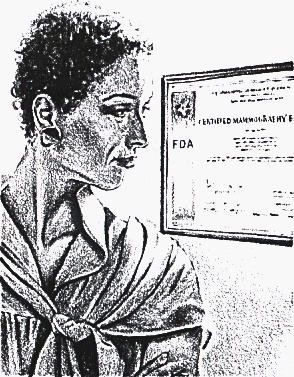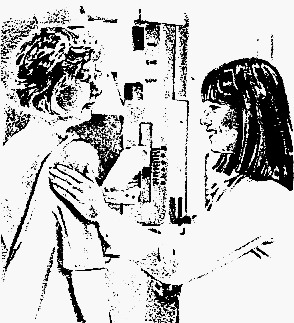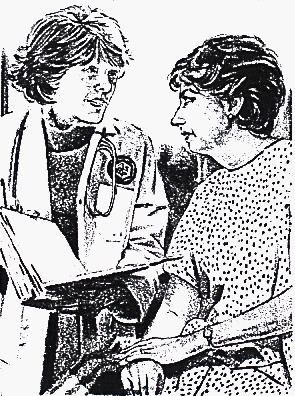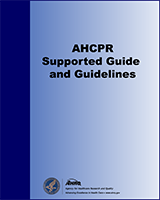NCBI Bookshelf. A service of the National Library of Medicine, National Institutes of Health.
Agency for Health Care Policy and Research (US). AHCPR Consumer Guides. Rockville (MD): Agency for Health Care Policy and Research (US); 1992-1996.
This publication is provided for historical reference only and the information may be out of date.
What is a Mammogram?
A mammogram is a safe, low-dose x-ray picture of the breast.
Mammograms are taken during a mammography exam. There are two kinds of mammography exams-screening and diagnostic.
A screening mammogram is a quick, easy way to detect breast cancer early, when treatment is more effective and survival is high. Usually two x-ray pictures are taken of each breast. A physician trained to read x-ray pictures-a radiologist-examines them later.
It is generally agreed that screening mammography decreases deaths from breast cancer in women 50 and over. There is a range of opinion about the value of screening mammography for women under 50.
Have a screening mammogram as often as your doctor or other health care provider suggests. A screening mammogram often can show breast changes like lumps long before they can be felt.
A diagnostic mammogram is used if there may be a problem. It is also used if it is hard to get a good picture because of special circumstances (for instance, in women with breast implants). Diagnostic mammography takes a little longer than screening mammography because more x-ray pictures usually are taken. A radiologist may check the x-ray pictures while you wait.
Purpose of This Booklet
This booklet can help you learn more about getting the best possible mammogram. Being informed will help you work with members of your health care team before, during, and after your mammogram to get quality, reliable results.
Many types of health care providers can help you with your breast care. Doctors, nurses, nurse practitioners, and physician assistants can examine your breasts, refer you for mammography when appropriate, and help you get more exams if they are needed. In this booklet, the word "doctor" is used for easier reading, but any of these health care providers can provide good care.
At the mammography facility, the person who takes the x-ray pictures (the radiologic technologist), the radiologist, and the people who keep the equipment in top working order have all had special training in mammography. They work as a team to make sure you get the best mammogram possible.
After your mammogram, your doctor receives your mammography results. Make sure you get your results from either your doctor or the mammography facility.
Make sure you understand the results and any recommendations for followup. And never be afraid to ask questions.
Following the seven steps in this booklet can help you maintain your breast health. Stay on top of things every step of the way.
Seven Steps to Breast Health
1. Get regular exams
This is the most important way you can protect your breast health.
- Get a breast exam from your doctor when you get your regular physical exam.
- Get a mammogram as often as your doctor recommends. Ask your doctor when to schedule your next mammogram.
- Check your breasts each month. Your doctor can show you how.
These three exams can help you and your doctor learn what is normal for your breasts and what may be signs of problems.
Call your doctor if you notice
- A lump or thickening of the breast.
- A discharge from the nipple that stains your bra or bedclothes.
- Skin changes in the breast.
These changes may be normal, but you should always have them checked as soon as possible.
2. Choose a quality facility
Many hospitals, clinics, and imaging or x-ray centers perform mammography. Mobile units (often vans) offer screening at shopping malls, community centers, and offices. All of these facilities must meet the same quality standards.
Your doctor may refer you to a mammography facility. Or you may select the one that is most convenient for you.
Make sure the mammography facility you choose is certified by the Food and Drug Administration (FDA) unless it is a Veterans Health Administration (VHA) facility.
A new law, called the Mammography Quality Standards Act, requires all mammography facilities except those of VHA to be FDA certified beginning October 1, 1994. To be certified, facilities must meet standards for the equipment they use, the people who work there, and the records they keep. VHA has its own high-quality mammography program, similar to FDA's.
If the facility is not FDA certified, get your mammogram in a facility that is certified.
To find a certified mammography facility, ask your doctor or call the National Cancer Institute's Cancer Information Service toll free at 800-4-CANCER.
3. Schedule the mammogram for when your breasts will be least tender
During mammography, the breast is pressed between two clear plastic plates for a few seconds. This gives a clear picture of the breast with the least amount of x-rays. But it may be uncomfortable, and a few women complain of some pain.
If you have sensitive breasts, try having your mammogram at a time of month when your breasts will be least tender. Try to avoid the week right before your period. This will help to lessen discomfort.
4. Give and get important information when you schedule the mammogram
When you call for an appointment, be ready to provide information the mammography facility needs to know. The facility may wait until your appointment to ask some questions, so it's a good idea also to take the information with you when you have your mammogram. The information requested may include:
- Your name, address, and phone number.
- Your age.
- Name, address, and phone number of any facility where you have had a mammogram.
- Any breast disease in your family.
- Any current problems with your breasts, and how long you have had the problems.
- Past problems with your breasts, breast biopsies, or breast surgeries.
- Whether you have breast implants.
- Other personal information:
- Whether you are pregnant or nursing.
- The timing of your menstrual cycle or when menopause began.
- Anything that might make it harder to do a mammogram (unusually large breasts or inability to stand, for example).
- Name, address, and phone number of your doctor.
Here are some questions for you to ask before your appointment:
- How and when you will find out the results of the exam.
- What you need to do to prepare for the exam. (See page 8 of this booklet for more information.)
If you have any other questions before your mammogram, be sure to call your doctor or the mammography facility.
5. Know what to expect
Understanding what happens during a mammogram will help reduce any anxious feelings you might have. It is important to know that only a small amount of radiation is used in mammography.
When you have a mammogram, you stand in front of a special x-ray machine. The radiologic technologist lifts each breast and places it on a platform that holds the x-ray film. The platform can be raised or lowered to match your height.
The breast is then gradually pressed against the platform by a specially designed clear plastic plate. Some pressure is needed for a few seconds to make sure the x-rays show as much of the breast as possible.
This pressure is not harmful to your breast. In fact, flattening the breast lowers the x-ray dose needed.
Studies show that most women do not find a mammogram painful for the short time needed to take the picture. Try to relax. If the pressure becomes painful, you can tell the radiologic technologist to stop.
If there is an area of your breast that appears to have a problem, the radiologist or radiologic technologist may examine the breast.
6. Come prepared
- Wear a two-piece outfit so you will have to remove only your top.
- Don't use deodorant, talcum powder, or lotion under your arms or near the breasts that day. These products can show up on the x-ray picture.
- Bring the name, address, and phone number of your doctor or other health care provider.
- Bring a list of the places and dates of mammograms, biopsies, or other breast treatment you have had before.
- Ask the facilities where you had mammograms before to release them to you, and bring them with you if possible. Your new mammogram can be compared with the earlier ones to see if there have been any changes.
It also may be helpful to:
- Bring a list of any questions you may have about mammography and your mammograms.
- If you think you may have trouble hearing or understanding the instructions, consider bringing a friend or family member to help you.
- If you are worried about discomfort, you may want to take a mild over-the-counter pain reliever about an hour before your mammogram. This will not affect the mammogram.
If there is something you do not understand, ask. And keep asking until all your questions are answered.
7. Follow up on your results.
Learning the results of your mammogram is very important.
Chances are your mammogram will be normal. But do not assume that your mammogram is normal just because you have not received the results. If you have not received your screening results within 10 days, ask your doctor or call the mammography facility.
If your screening mammogram shows anything unusual, talk to your doctor as soon as possible about what you should do next. Your doctor may schedule a diagnostic mammogram, or you can schedule it yourself-but have it done soon. Discuss the results with your doctor.
When a diagnostic mammogram shows something abnormal, the radiologist may recommend another type of exam. A biopsy is a way to obtain a small piece of breast tissue for study under a microscope. Sometimes a biopsy is needed because of something your doctor found in checking your breast even though the mammogram appears normal.
Whenever a mammogram uncovers a problem or a need to check something further:
- Make sure you understand what you need to do next.
- Always get results of any test that you have.
- Ask questions about your results if something is hard to understand.
If you do not have a doctor or other health care provider, you will need to find one if you have an abnormal mammogram. Ask the mammography facility to help you find a doctor. Then make an appointment right away so you can discuss your results and what should be done next.
Mammography is very effective, but it does not detect all breast problems. If you find something unusual in your breast, see your doctor.
You're in charge of your breast health
- Schedule screening mammograms as often as your doctor recommends.
- Always find out the results of your mammogram.
- Follow your doctor's recommendations for follow-up and schedule diagnostic mammography, if needed, as soon as possible.
- Have your doctor check your breasts as part of your regular physical exam, and check your breasts yourself each month.
- If you have a breast lump or change at any time, even if your last mammogram was normal, see a doctor as soon as possible.
How Can I Learn More About Mammography?
Most mammography facilities have printed information and videotaped instructions on breast care. You can read or watch them when you go for a mammogram.
For general information on breast cancer and mammography, contact:
- Cancer Information Service (a service of the National Cancer Institute).
- 800-4-CANCER
- Food and Drug Administration (FDA)
- MQSA Consumer Inquiries
- 1350 Piccard (HFZ-240)
- Rockville, MD 20850
- American Cancer Society
- 800-227-2345
Use this page to keep a record of every time you go for a mammogram-the date, the name and address of the facility, and its telephone number.
Doctor or other health care provider: Date of mammogram:__________________
Facility:___________________________ Address:____________________________
Phone:______________________________ Date of mammogram:__________________
Facility:___________________________ Address:____________________________
Phone:______________________________ Date of mammogram:__________________
Facility:___________________________ Address:____________________________
Phone:______________________________ Date of mammogram:__________________
Facility:___________________________ Address:____________________________
Phone:______________________________
For Further Information
The information in this booklet is based on the Clinical Practice Guideline, Quality Determinants of Mammography. The Guideline was developed by a non-Federal panel of experts sponsored by the Agency for Health Care Policy and Research. Other guidelines on health issues are available, and more are being developed.
For more information about guidelines or to receive more copies of this booklet, call toll free:
- 800-358-9295
- Agency for Health Care Policy and Research
- Publications Clearinghouse
- P.O. Box 8547
- Silver Spring, MD 20907
Figures
Credit: Illustrations by Donald Gates.
When you go to the mammography facility, look for a certificate as proof that the facility is certified by FDA
When you go to the mammography facility, look for a certificate as proof that the facility is certified by FDA. It should be displayed some place where it is easy to see and read.

When you call for an appointment, be ready to provide information the facility needs to know

The radiologist or radiologic technologist may examine the breast

Discuss the results with your doctor

- AHCPR Publication No. 95-0634.
- Things to Know about Quality Mammograms: A Woman's Guide - AHCPR Consumer GuidesThings to Know about Quality Mammograms: A Woman's Guide - AHCPR Consumer Guides
- Clostridioides difficile Y171 gcdY171.contig.172, whole genome shotgun sequenceClostridioides difficile Y171 gcdY171.contig.172, whole genome shotgun sequencegi|531544686|gb|AVKW01000173.1||gnl AVKW01|gcdY171.contig.172Nucleotide
Your browsing activity is empty.
Activity recording is turned off.
See more...
